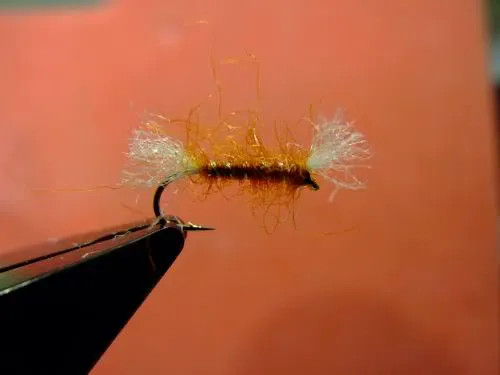THE SHIPMAN'S BUZZERHere’s one of my all time favourite dry flies on Stillwater. Initially designed by Dave Shipman in then late 70’s and popularised during the dry fly revolution on still waters in central England’s reservoirs I first came across it as a freebie with a magazine – Trout fisherman I think. It was a size 12 and it caught me a few fish on ponds in the central belt. More recently I have been tying it in smaller sizes, down to 18’s for spooky fish in hot bright evenings.
It really is a simple fly and quite easy to tie:
1. Materials: Simple – hook (Lightweight I’ve used B 400), thread - black in this case, white poly yarn, pearly rib and your favourite dubbing – I have used fiery brown seal (though the original was antron) but I also use claret, black amongst others. F.B. is my favourite!

2. Ok Hook in vice, flick to test the temper though I can’t remember the last hook which broke.

3. Attach the tread at the eye (a wee tough of dubbing wax here will hold the thread after a couple of turns.

4. Catch in the poly yarn for the wing and secure with a couple of tight turns

5. Hold the wing up at about 45 degrees and wind in touching turns. This keeps the wing on top of the shank.

6. Continue winding to the end of the shank of the hook.

7. Now return the thread in open turns to the front of the fly.

8. Catch in the rib. Originally it was pearl tinsel but the first fish you hook will destroy it so, after experimenting with two ribs, one tinsel one fine nylon I came across this, pearly strand wound round a nylon core. Think its called twinkle(Lureflash).
Pulling it down as you wind to the band will ensure it stays on the bottom of the hook.

9. Dub the thread evenly with your chosen dubbing, keep it fairly fine.

10. Wind the dubbing to just short of the eye of the hook.

11. Wind the rib in an open spiral and tie off with a couple of turns of waxed thread.

12. Snip off the excess rib material and whip finish the fly under the wing. I usually do two three turn whips one on top of the other – saves using varnish. Then trim the wings to length. Leave them long to start and trim as required..

13. rough up the body with a wire brush or Velcro

14. et Voila – finished!!

Apply floatant to the wings and the fibres sticking up when fishing the fly. Remember it should fish in the surface not on top. Fish it static or with short pulls.

